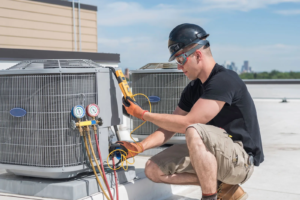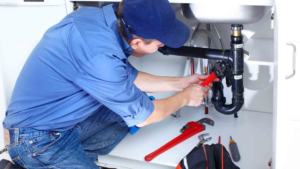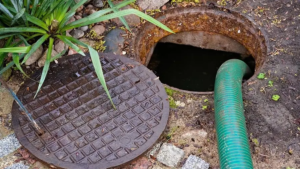HVAC (heating, ventilation and air conditioning) systems keep us warm in the winter and cool in the summer. They also help to control indoor humidity.
A properly sized system is critical to energy efficiency. A too-large system wastes money by consuming more power than necessary. Make sure to have your Ernst Heating & Cooling expert recommend the best size for your home. Visit https://www.taphvac.com/ to learn more.

Heat pumps can generate two to three times more heat than they consume in electricity, making them one of the greenest choices for heating homes. The air-source variety uses refrigerant-filled coils, not too different from those on the back of your fridge, to move heat into and out of your home in winter.
As heat energy moves from higher to lower temperatures and pressures, it naturally wants to transfer to areas that can absorb the energy. Your heat pump harnesses this process, using an outdoor unit to pull hot or cold air from the air, and a indoor coil to heat or cool the house.
Ducted: The indoor coil is located in a duct system that distributes the heated or cooled air to different locations in the house. A single indoor unit serves multiple ducts, or a multi-split system can serve several separate ducts in the same house.
A heat pump that’s been running in heating mode for too long can develop frost on the outdoor coil, reducing its efficiency and forcing it to run longer. This frost needs to be melted in order for the heat pump to function normally again, so it’s important that it only run when needed. Typically, the reversing valve will activate a defrost cycle when it detects that the outdoor temperature is near freezing.
The reversing valve will also change the flow of refrigerant so that it’s going to the evaporator instead of the compressor, which means that the outside coil becomes the heater and the inside coil becomes the condenser. The accumulator collects any liquid refrigerant that doesn’t vaporize into gas, and the compressor squeezes the molecules together, increasing their temperature so that they can transfer thermal energy to the evaporator and the indoor coil.
Unnecessary defrost cycles waste energy, so your Carrier dealer can help you set up a demand-frost system that only starts a defrost cycle when the system senses it’s necessary. In the meantime, you can prevent unnecessary defrost cycles by ensuring that the outdoor unit’s vent is free of leaves, snow and any other obstructions.
Ductless Systems
Ductless systems, also known as mini-split air conditioning units, are a popular alternative to traditional ducted HVAC. They’re especially useful for new additions to a home such as sunrooms, attics and garages, or for older homes without existing ductwork. While ductless systems are more expensive than window units or baseboard heaters, they’re much more energy efficient. And they save you the expense of extending and maintaining your home’s ductwork.
Unlike a ducted system, which cools all rooms with one unit, a ductless system comes with multiple indoor units that connect to an outdoor unit via conduit, suction tubing and condensate drain lines. The evaporator or blower units in each room are controlled independently with their own remotes, so you can adjust your comfort settings according to the occupied space. The cooling process is managed by a heat transfer cycle that uses refrigerant, which absorbs and releases heat. The process is more energy efficient than a conventional AC system because it only powers up the indoor air handlers when you need them.
Another benefit of ductless systems is their quiet operation. The indoor units are usually designed to operate at 19 decibels, or about the noise level of rustling leaves or whisper. They’re far quieter than humming central AC systems or loud, banging window units.
When you have a ductless system installed, you can take advantage of a range of federal, state and local tax credits and utility rebates. You can also save up to 30 percent in heating and cooling costs by using a ductless system with ENERGY STAR ratings.
As with any HVAC system, proper sizing and installation are important for getting the most from your ductless system. An HVAC professional can help you choose the right unit for your needs and install it correctly. A faulty installation can waste money and damage your system, while sizing issues can lead to short cycling. Short cycling occurs when your system turns on and off frequently, which causes it to use more energy than necessary to reach and maintain a set temperature.
Air Filters
Air filters are a critical part of any central heating, ventilation and air conditioning system (HVAC). They improve indoor air quality by removing allergens and other airborne pollutants that can cause respiratory problems and even illness. An HVAC professional can help you find the best air filter for your home by explaining how different types of filters work.
A filter’s job is to act as a lightweight barrier between your circulated air and the debris inside the blower, fan and coils of your system. It prevents dust, dirt and other debris from accumulating in the system, which can shorten its lifespan and reduce efficiency. An air filter also traps contaminants, which prevents them from being circulated throughout your home, which can worsen allergy and asthma symptoms.
There are four basic ways that an air filter can catch pollutants. Large particles are caught by inertial impaction. As they move through the filter, they follow the path of air flow and collide with filter fibers. When this happens, they stick to the fiber and are trapped. Air filters with higher minimum efficiency reporting values (MERV) can be more effective at preventing smaller particles from passing through the filter medium, although they may not have as much surface area to hold them.
The next method of air filtration is electrostatic attraction. As air passes through the filter, it receives a static electric charge from the woven fibers. This causes the particles to adhere to oppositely charged fibers and get stuck in the filter. This is especially useful for filtering out smoke, smog and pet dander.
A filtration system that uses carbon can also neutralize harmful chemicals in the air. These filters are often used in hospitals and clean rooms because they can remove airborne bacteria, viruses and mold spores.
Dirty air filters can cause the system to work harder to move air, which can lead to overheating or freezing in your home. They can also restrict airflow, which can strain the fan motor and other components of your ductwork. Over time, this can result in expensive repairs and energy bills. When you purchase a new air filter, keep in mind its MERV rating and size to determine how well it will perform.
Thermostats
A thermostat is an important part of any hvac system. It monitors the temperature in a room and compares it to your pre-set settings. Then it sends a signal to the system to alter the air to bring it closer to your desired temperature setting. Thermostats come in a variety of models and have different features to suit your needs.
Basic thermostats work on a simple principle: heat makes things expand, and cold causes them to contract. The heat from your home’s ductwork flows into the thermostat, which senses this temperature by measuring current through a metal strip inside. Then it switches the heating on if the temperature is too low or off if it’s too hot. This is how most of the world’s thermostats operate, including programmable ones.
One of the coolest features on some thermostats is the heat anticipator, which is designed to shut off the heating before the room reaches your set temperature. This prevents the heating from constantly switching on and off, which can waste energy.
Some thermostats have a wire box underneath them that holds all the electrical connections. If the thermostat malfunctions, you may be able to fix it by removing the wires and re-connecting them to their correct connectors on the back of the thermostat. The color code of the wires can help you figure out where to connect them, and you can always look up the wire’s terminal on your model’s schematic diagram if you’re unsure.
Most thermostats have a wire with a red, white and blue connection, and most also have two black wires. The red and white wires are connected to the polarized terminal of the mercury switch, while the black wire connects to a lug on the circuit card. The lugs are marked with the first letter of each wire’s colour, so you can quickly identify them by their colors and connector labels.
Once you’ve connected the wires to their correct connectors, you can reinstall the thermostat and turn on power at the breaker box. If the thermostat still doesn’t activate, there are many possible issues that could be causing it to malfunction. These include blown fuses, dead batteries, or dust buildup.


